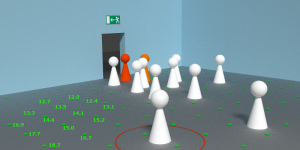We act as and are confronted with pedestrians and crowds everywhere in our daily routine. As Vuchic (1999) says in his book Transportation for Livable Cities: “Every trip begins and ends on foot, even if only to and from a car”. This year’s Conference on Traffic and Granular Flow will be hosted by the Delft University of Technology in the Netherlands. The conference’s scope explicitly includes a wide range of systems: from granular particles to cars and pedestrians. Although there are physical similarities among those systems, humans are active agents and not only subject to physical forces imposed on them as in the case of granular flow. With computer simulations, we aim to predict pedestrian and crowd motion using mathematical models. For the development of a computer simulation of pedestrian dynamics, many different scientific areas are of interest, such as mathematical modelling, software development, statistical analysis, and social psychology. Therefore, developing a crowd simulation is highly interdisciplinary. The models we use for simulation can help to understand the mechanisms within a crowd that lead to certain phenomena, such as lane formation in bi-directional flow or obstruction at bottlenecks. Furthermore, the simulation outcome is a prediction of what would happen in real life, according to the model. Although simulation models have only limited predictive accuracy in general situations, they may help to make informed decisions when faced with a specific problem.

Illustration of a pedestrian stream simulation. Simulated pedestrians pass through the door in a room egress scenario.
With an education in informatics and statistics, I study and develop microscopic pedestrian stream simulations. My focus is on modelling and validation methodology. Currently, I am interested in simulation models that reflect the underlying physical, psychological, and social processes of pedestrian and crowd behaviour. However, there is a certain limitation to what can be incorporated from psychology, since most approaches aim to reproduce specific phenomena without considering the underlying processes. Therefore, I try to follow a modelling paradigm that has been put forward in psychology and artificial intelligence: cognitive heuristics. As the proponents of this concept say: humans cannot always find the optimal solution to a problem, but rather try to find a “good enough” solution. This seems especially plausible for pedestrians’ walking behaviour, since decisions often have to be made quickly with limited information about the environment available. The paradigm of cognitive heuristics may facilitate the integration of modern concepts from psychology into pedestrian stream simulations and lead to new insights in decision-making processes.
By Michael Seitz


Leave a Reply